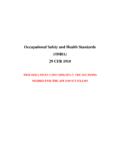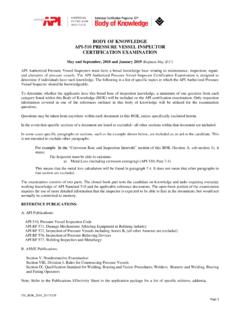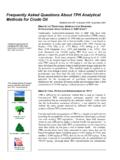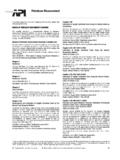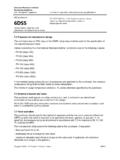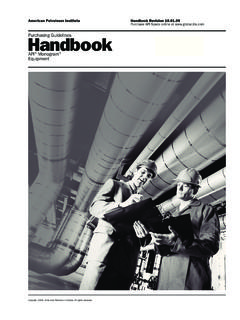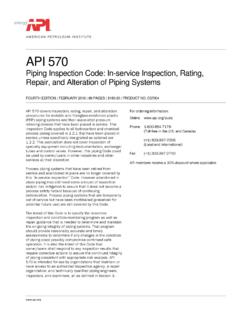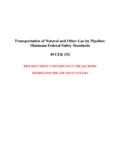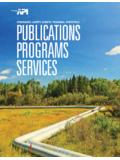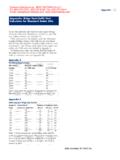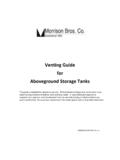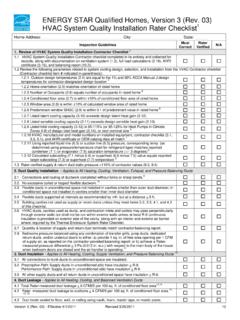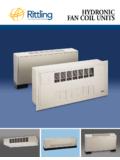Transcription of API Standard 521
1 API Standard 521. Pressure-relieving and Depressuring Systems SIXTH EDITION | JANUARY 2014 | 248 PAGES | $ | PRODUCT NO. C52106. This Standard is applicable to pressure-relieving and vapor For ordering information: depressuring systems. Although intended for use primarily in oil refineries, it is also applicable to petrochemical Online: facilities, gas plants, liquefied natural gas (LNG) facilities, and oil and gas production facilities. The information Phone: 1-800-854-7179. provided is designed to aid in the selection of the system (Toll-free in the and Canada).
2 That is most appropriate for the risks and circumstances involved in various installations. (+1) 303-397-7056. (Local and International). This Standard specifies requirements and gives guidelines for the following: Fax: (+1) 303-397-2740. examining the principal causes of overpressure;. API members receive a 30% discount where applicable. determining individual relieving rates;. selecting and designing disposal systems, including such component parts as piping, vessels, flares, and vent stacks. This Standard does not apply to direct-fired steam boilers.
3 The portions of this Standard dealing with flares and flare systems are an adjunct to API Standard 537, which addresses mechanical design, operation, and maintenance of flare equipment. It is important for all parties involved in the design and use of a flare system to have an effective means of communicating and preserving design information about the flare system. To this end, API has developed a set of flare datasheets, which can be found in API 537, Appendix E. The use of these datasheets is both recommended and encouraged as a concise, uniform means of recording and communicating design information.
4 Contents Page 1 Scope .. 1. 2 Normative References.. 1. 3 Terms, Definitions, Acronyms, and Abbreviations .. 1. Terms and Definitions .. 1. Acronyms and Abbreviations .. 10. 4 Causes of Overpressure and Their Relieving Rates .. 11. General .. 11. Overpressure Protection Philosophy .. 12. Hierarchy of Protective Measures.. 12. Use of Administrative Controls if Corrected Hydrotest Pressure Not Exceeded .. 12. Double Jeopardy .. 13. Latent Failures .. 13. Operator Error/Effect of Operator Response .. 13. Role of Instrumentation in Overpressure Protection.
5 14. Determination of Individual Relieving Rates .. 14. General Philosophy.. 14. Effects of Pressure, Temperature, and Composition .. 15. Dynamic Simulation .. 15. Individual Overpressure Causes and Their Relieving Rates .. 16. General .. 16. Closed Outlets.. 16. Cooling or Reflux Failure .. 18. Absorbent Flow Failure .. 20. Accumulation of Noncondensables .. 20. Entrance of Volatile Material into the System.. 20. Overfilling .. 21. Failure of Automatic Controls .. 22. Abnormal Process Heat or Vapor Input .. 26. Internal Explosions or Transient Pressure Surges.
6 29. Chemical Reaction .. 30. Hydraulic Expansion .. 31. Fires.. 36. Heat Transfer Equipment Failure .. 54. Utility Failure .. 58. Overpressure Prevention During Maintenance .. 60. Guidance on Vacuum Relief .. 61. General .. 61. Causes for Vacuum .. 61. Protection Against Vacuum.. 62. Vapor Depressuring .. 62. General .. 62. Initiation of Depressuring .. 63. Low Temperatures During Depressuring .. 63. Application Criteria .. 64. Acceptance and Design Criteria .. 64. Depressuring Rate .. 66. Vapor Flows .. 66. v Page Relief System Design Documentation.
7 71. General .. 71. Purpose of Documentation .. 71. Potential Elements of Relief System Design Documentation.. 71. Flare Header Design Documentation .. 75. Special Considerations for Individual PRDs .. 76. General .. 76. Liquid-Vapor Mixture and Solids Formation .. 76. Location of a PRD in a Normally Liquid System.. 76. Multiple PRDs .. 76. 5 Disposal Systems .. 77. General .. 77. Fluid Properties That Influence Selection and Design of Disposal Systems.. 77. Physical, Chemical, and Reactive Properties.. 77. Temperature .. 78. Hazardous and Nuisance Properties.
8 79. Viscosity and Solidification .. 79. Miscibility .. 79. Recovery Value.. 80. System Design Load .. 80. General .. 80. Loads from Pressure Systems .. 80. Establishing Design Load for the Disposal System .. 81. Refinement of the Disposal System Design Load .. 82. System Arrangement .. 82. General .. 82. Single-device Disposal Systems.. 83. Multiple-device Disposal System .. 84. Header Segregation .. 84. Piping .. 85. General .. 85. Backpressure .. 86. Line Sizing.. 86. Multiple-relief Scenarios .. 87. Isothermal Pressure Drop Calculation Method.
9 87. Lapple Pressure Drop Calculation Method.. 90. Fanno Lines Pressure Drop Calculation Method .. 93. Nonideal Gas Behavior .. 93. Frictional Resistance of Fittings (K-factors) .. 94. Mixed Phase Fluids.. 94. Mechanical Design of the Disposal System .. 97. Acoustic Fatigue .. 97. Setting the Mechanical Design Temperature for Flare Headers .. 100. Reaction Forces .. 100. Shock Loading .. 101. Pipe Anchors, Guides, and Supports .. 101. Self-draining/Heat Tracing .. 101. Routing of Discharge Piping/Sloping .. 101. Disposal to a Lower-pressure System.
10 102. Disposal to Flare .. 102. General .. 102. Combustion Properties .. 103. vi Page Combustion Methods .. 112. Flare Systems Designs .. 120. Sizing.. 122. Purging .. 124. Ignition of Flare Gases .. 127. Liquid Seal Drum.. 128. Flare Knockout Drum .. 133. Siting Considerations for the Flare .. 140. Flare Gas Recovery Systems .. 140. Disposal to Atmosphere .. 144. General .. 144. Formation of Flammable Mixtures .. 144. Exposure to Toxic Vapors or Corrosive Chemicals .. 151. Ignition of a Relief Stream at the Point of Emission .. 152. Excessive Noise Levels.
